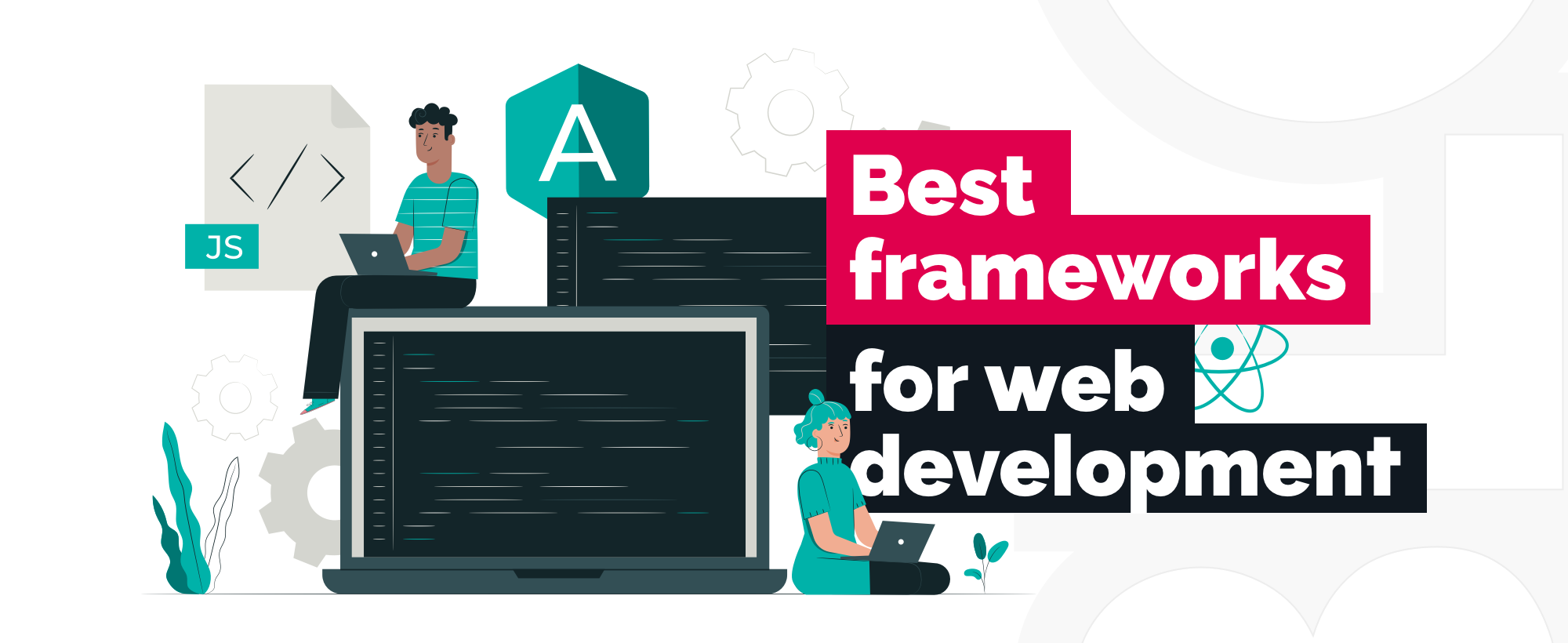10 Best Frameworks for Web Development in 2023


Choosing the top web development frameworks for your website and web apps determines the progress of your web project. Learn what tech stacks are best for different types of products.
When we are talking about web development services, we can’t go without mentioning JavaScript. It’s a go-to language for single-page applications, rich-functionality apps, and all kinds of web frontend. The majority of web frontend is written with JS, and JS developers are predictably among the most requested specialists in the technology field.
JS is not a simple language, though, primarily due to complicated semantics. Wiring a JavaScript app entirely from scratch would take a lot of time. This is where the frameworks come in — they offer libraries of pre-written code and additional features.
We reviewed the eight best web development frameworks with their pros and cons. There’s no perfect option, but you can choose the one that fits your project. So, here’s a detailed web framework comparison with advantages and disadvantages.
#1 React.js
One thing you need to understand about React.js development before starting using it is that React.js is not a full-fledged framework. This is why it’s not right to expect React.js to deliver the functionality of Angular or Backbone. It’s a code library for writing the JS interface, but it has the essential features of the best web frameworks.
Advantages
- React Native for mobile apps: React supports different tech stacks and languages, allowing to combine new features with existing code. For mobile development, you can use React Native — the React-based framework dedicated to hybrid mobile development (both iOS and Android).
- Fast code rendering: React quickly interprets HTML-based code into the actual page layout. This framework for web development allows declarative views, updating the interface whenever the code is changed.
- SEO-friendly: optimizing a single page to multiple keywords is difficult because index bots need to understand JS requests. Most React development company offers a set of instruments for helping indexation bots recognize the content of the page and optimize the site.
Disadvantages
- Complicated documentation — React is hard to navigate due to the high number of dependencies.
- Space-consuming size: you need to install a lot of additional components and code collections to React efficiently.
#2 Angular
Angular was among the earliest JavaScript frameworks, as well as among the most popular web frameworks. It was supported by Google and offered easy methods for MVC architecture, data processing, dependency handling, and built-in modules. For 2012, this was a significant leap forward — no wonder it’s still the most popular web development framework.
Later on, the framework faced competition from React, Vue, and other libraries, so the team released a new version — Angular 2, compatible with new development standards.
Advantages
- Great for Rich Internet Applications. RIA are web applications that aim to deliver desktop functionality on the browser. The client interface handles user interface and activity; the server-side is responsible for data processing. Angular development company uses HTML to build user interfaces and breaks functionality in modules, perfect for managing complex functionality.
- Cross-browser availability: the framework supports the latest versions of Chrome, Firefox, Edge, Android, iOS.
- Open-Source: Angular code is available for free under the MIT license. You can also upload free tools and plugins to the framework from the user-curated community.
Disadvantages
- Not adapted to mobile devices — although Angular technically supports iOS and Android browsers, users often report bugs on mobile versions.
- Complicated Model-View-Controller Patterns. Typically in JS development, you write code from the controller perspective, not view (HTML). In Angular development, everything is HTML-centered.
#3 Vue.js
Vue.js is a framework for frontend development, known for its high speed and flexibility. It’s mostly used for interactive interfaces of web applications and sites. Vue.js has a simple core functionality that can be improved with libraries, add-ons, and APIs. Vue.js development is based on data-reactive tools that can be integrated with other projects and libraries.
Advantages
- Single File Components: you can edit your styles and templates in a separate file. These components mark segments of the code, improving codebase readability, and look similar to actual front-end.
- High scalability: Vue has a CLI project generator with an intuitive wizard which makes it easy to start a new project and transfer data from one codebase to another. You can improve the functionality of the generator according to your needs — Vue.js development services deliver plenty of additional plugins.
- Clear documentation: Vue docs are well organized and clear. API documentation is easy to find and read. It’s not a crucial difference, but the fact remains: other JS frameworks don’t live up to standards, set by Vue.js.
Disadvantages
- Difficult to learn: coding in Vue requires developers to learn practices that are untied to Vue, like directives. You can’t reuse that knowledge anywhere else or use previous JS experience to help yourself out. React, for instance, focuses less on specific features, and more on general best JS practices.
- Small community: Vue.js doesn’t have many forums, free educational resources, courses, and videos. It’s fine if you want to distinguish yourself from other JS coders, but for beginners, it’s a big downside.

#4 Svelte
Svelte is a code compiler for transforming declarative components into imperative JS code. Unlike many JS frameworks, this one performs the majority of the work in the compiler rather than in the browser. The framework makes automated updates to the Document Object Model as soon as the state of the software changes.
Advantages:
- Easy to read HTMLX syntax and templating system: these are elegant and fast to understand and read.
- Flexible output: Svelte output code can be adopted to React and Vue. The framework chooses which bundles to write depending on the components used by your application.
- Fast performance: Svelte has a reputation for being one of the fastest JavaScript frameworks out there. It can quickly resolve code performance issues (like minimizing dependencies) in the minimal runtime. With a powerful virtual DOM, Svelte can render frameworks without a single frame drop.
Disadvantages
- A small user community: even though Svelte is growing quickly, there’s not enough demand on the market, and educational resources are lacking as well. A lot more teams are adopting the framework, but it’s still an out-of-the-box solution rather than an established tech stack component for most web developers.
- Not enough add-ons: compared to Vue.js and React.js that have thousands of add-ons for all types of projects and devices, Svelte falls behind in number of integrations. Essential functionality of the platform, however well done, can’t substitute all these features.
#5 Node.js
Node.js is a JavaScript runtime environment built on the V8 engine. It has an open-source license and community. The framework runs on Linux, Mac OS, Windows, and other OSs. Its main advantage is that it can be used both to frontend and backend. You can use a single tech stack for the entire web project, or use Node.js for backend with other top web frameworks for the frontend — it’s up to you.
Advantages
- The same language for frontend and backend: Node.js code can be reused on the client and server-side.
- Fast performance: V8 is faster than engines used by several other main programming languages, for instance, CPython. This is because Node.js development proceeds with the JIT compiler — the just-in-time compiler compiles bytecode to machine code while the programme is running (it’s also used in Java).
Disadvantages
- Low efficiency of CPU-intensive performance: Node.js is a single-threaded language, which is why it does a poor job in handling CPU-intensive tasks (many tasks can’t be accomplished simultaneously).
- Coding takes more time: while universality is Node.js’ most significant benefit, it’s also its main structural flaw. The framework is unnatural: creators took front-end-specialized JavaScript, and artificially tweaked it to fit backend. No wonder that modules are often messy and redundant: for instance, you have nmp files that characterize the same functions.

#6 Ember.js
Ember.js is a relatively new framework that took the list of popular web development frameworks by storm. The main reason for this spike of popularity is Ember’s rich functionality. In essence, it includes all the best features of JS stack (Babel for ES2015 syntax support, Testem, and QUnit for unit and integration testing, etc.).
To work with Ember.js, you need to have the latest version of Node.js — they are available on the official website.
Advantages
- Efficiency: the framework uses Handlebars for navigation — one of the most efficient semantic builders on the market. It also features a live-reload that shortens the time for request processing.
- Big community: even though Ember.js is relatively new on the market, it already has a lot of contributors in the Open Source community and dedicated GitHub repositories.
- Large ready library: Ember offers ready packages for routing, data management, dependency handling solution, and Ember Addon — a collection of official tools.
Disadvantages
- Complex internal logic: Ember’s component structure is complicated and can be counter-intuitive for beginners.
- Slow development: complicated semantics slows down the development process, although Ember add-ons compensate for this.
#7 Backbone.js
If Angular’s specialty is mimicking the functionality of desktop applications, Backbone is considered the best web development framework for single-page applications. Web apps like Gmail or Twitter that don’t refresh pages are SPAs — they are fast and efficient.
The main characteristic of Backbone is that it depends only on the JS stack and uses model-view-presenter. If the MVC controller is responsible for business logic, in this solution, the function is performed by the presenter.
Advantages
- Small size and flexibility: Backbone is one of the smallest and fastest frameworks, not only in JS stack but in web development overall;
- Understandable functionality: Backbone uses event-driven algorithms to connect views and models, eliminating cluttered intermediate code. Also, you can connect it to REST APIs to sync the frontend with the backend.
Disadvantages
- Manual coding: Backbone offers a little amount of pre-set code compared to other JS frameworks.
- Memory leaking: Backbone’s code sometimes fails to return the memory space that was occupied for temporary purposes. The applications continue to take up memory, and over time, there’s not enough space left. Developers need to identify and eliminate these bugs manually.
#8 Meteor
Meteor’s primary specialty is cross-platform applications. The framework supports different browsers and mobile devices — developers can reuse their tech stack and integrate other languages. It’s among the fastest and most universal website frameworks — here’s why.
Advantages
- Reactivity: Meteor is a comfortable framework with simple, often primitive syntax. It won’t help you write a complex web project, but it’s perfect for small projects. Due to its simplicity, Meteor quickly renders code and displays changes.
- “Methods” make coding easier: Meteor uses methods to connect clients and servers. All requests, sent by a user, are processed via a method on the server-side. You can join a particular method to a specific type of user request, assuring a better performance.
- Enables full-stack development: you can use Meteor for frontend, backend in connection to REST API, and mobile development.
Disadvantages
- Limited database support: for now, Meteor only works with MongoDB;
- Documentation issues: Meteor’s documentation is lengthy and difficult to read.
#9 jQuery
jQuery is a widely-used JavaScript framework that helps web developers create more dynamic and interactive websites. It simplifies the process of scripting various elements, such as document traversing, animating, event handling, and Ajax interactions. Among its many powerful features are access to cross-browser support, optimized performance, increased efficiency when writing code and extended functionality.
jQuery is an effective tool for developing productive applications with fewer lines of code than regular JavaScript and offers elements that can be added to existing HTML pages with minimal effort. The way designers write JavaScript has been transformed by jQuery's extensibility and adaptability.
Advantages:
- The DOM can accommodate the addition and deletion of elements.
- HTTP request transmission has been streamlined.
- Dynamic content and streamlines HTTP requests.
Disadvantages:
- Slow pace of work.
- The document object model's APIs are no longer relevant.
#10 Next.js
Next.js is an open-source React framework created by Zeit. It enables developers to create modern websites and apps with enhanced performance capabilities. The tool makes it easy to build dynamic web products while ensuring they load quickly. Additionally, Next.js comes with built-in tools such as routing, CSS support, automatic code splitting, and ES modules that make developing applications faster than ever.
The UI is built using JavaScript and React components from Next.js. React Router, Webpack, the Node ecosystem, and open-source tools are influences on Next.js. Next.js's incremental static generation functionality, which enables statically generated pages to be updated progressively as new material is added or changed, is another distinctive feature.
Advantages:
- You can reach the market more rapidly while saving time and money if you use pre-made components. These elements can help your teams quickly improve and accept iterations.
- Design with flexibility and responsiveness so that it will appear great on any device, no matter the size of the screen.
Disadvantages:
- Plugin system is poor in Next.js.
- Except for a Node option for dynamic routing, routing is restricted.
- When an application has multiple pages, the build time becomes quite important.
Web Development with TechMagic
Web development framework for JavaScript shapes the way web development is done today. Now that team has so many choices, it’s easy to find a tool that fits the functionality of the project like a glove. Whatever project you are planning — be it a rich application or a single-page app — there is the best framework for web development for your needs.
If you have a web development project in mind, don’t hesitate to contact TechMagic’s web developers. As a software product development company provider, we will help you choose the right tech stack for front- and backend, applying JavaScript frameworks 2023 trends.




 facebook
facebook
 twitter
twitter






















